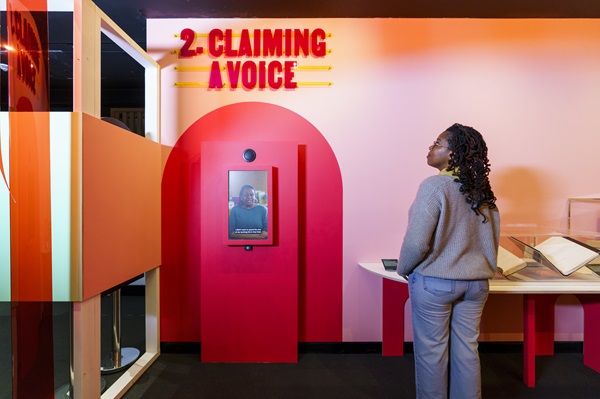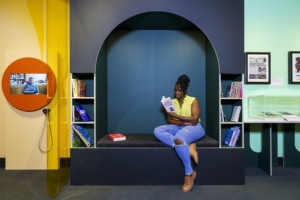
This article is in the Beyond The Secret Garden Category
Beyond the Secret Garden: The Power of Exhibitions
In the latest in our long-running Beyond the Secret Garden series, Darren Chetty and Karen Sands-O’Connor explore exhibitions of children’s books.
In the late 1990s, the British Library ran an exhibition of children’s books (it was called Children’s Books at the British Library). The poster for the exhibition featured a picture from Janet and Allan Ahlberg’s Jolly Pocket Postman (1995) of a giant Alice towering over a forest containing tiny figures from L. Frank Baum’s The Wizard of Oz (1900) while the cow jumped over the moon. The Ahlbergs’ postmodern pastiche was a perfect advertisement for 1990s Cool Britannia: classic children’s literature with the British figure (Alice) writ large, yet with all the Victorian era politics stripped away.
This includes the uncomfortable racial politics of classic children’s literature; all the human figures on the poster are white (and as we have discussed in other columns, classic children’s literature is far from an all-white world). Just as you shouldn’t judge a book by its cover, you can’t judge an exhibition just by its poster—but posters, like covers, are a choice about what will appeal to viewers and make them enter the space inside the book or exhibition. Authors and characters of colour have rarely been the focus of children’s book exhibitions in Britain. But recently, that has begun to change.
In 2022, Listen to this story! An exhibition about children’s books and Black Britain was produced in Newcastle, as we wrote about last year. The exhibition focused on community, identity and voice in Black British book creation, and the poster featured an illustration from Errol Lloyd, the pioneering Black children’s book author-illustrator who also played a critical role in promoting and supporting Black art in Britain. The poster picture, of two schoolgirls reading, was a deliberate choice to celebrate both Black childhood and reading in a single image. In 2023, London caught up with the north by producing two significant exhibitions featuring Black British children’s books: Stratford’s Discover Story Centre produced The Box Rocket exhibition based on Dapo Adeola and Nathan Bryon’s popular Black British character, Rocket. The window of the Discover Story Centre in Stratford, east London, was covered by a larger than life-size illustration of Rocket under the exhibition title, with the tagline ‘An interactive, intergalactic exhibition’. This was not an exhibition about Look Up! (2020), which won the Waterstone’s Book Prize and first featured the character of Rocket, but a new narrative experience designed by Adeola and Tọlá Okogwu (whose Onyeka and the Secret Superhero is a forthcoming World Book Day book). While reading and words play a critical role in the experience, the focus is on children and creativity. This is typical for the museum, which (according to their website) is designed to be ‘a place where children and their families can enjoy playing, learning and making up stories together’. But the fact that this exhibition (which will continue through January 2024) foregrounds a Black character who has been an inspiration for many young readers (the number of ‘Rocket’ costumes appearing on social media for World Book Day has been increasing every year) suggests that the definition of Britishness in children’s literature is changing to become more reflective of society, and that this can be seen across the entire cultural sector.
In autumn of 2023, the British Library opened two exhibitions which exemplify these changes, as well as the limits of those changes. The first, a ticketed exhibition on Fantasy: Realms of Imagination, was advertised through an original poster by Ukrainian-born artist Sveta Dorosheva. The poster, a complex collage of several fantasy characters from around the world (although mostly British and European sources, including Alice in Wonderland, the Chronicles of Narnia, and Lord of the Rings), was designed to recall ‘Golden Age storybook artists such as Arthur Rackham, Edmund Dulac and Kay Nielsen, alongside her love of medieval manuscripts’ (illustrationx.com). However, it does include books by and about people of colour, notably Hayao Miyazaki’s Princess Mononoke and No-Face from Spirited Away. The exhibition itself is even more inclusive; Andrew Salkey’s and James Berry’s versions of Anansi stories feature; also drafts of Ursula LeGuin’s Wizard of Earthsea (1968) which features a main protagonist of colour; as well as epics, legends and fairy tales from around the world. The exhibition is not focused on children’s fantasy, but those children who are interested in fantasy worlds would find a few reflective mirrors into our own world there.
 At the end of November, the British Library opened its first exhibition dedicated to a children’s author of colour, Malorie Blackman. The poster for this exhibition features Blackman’s photo from the hardback cover of her biography, Just Sayin’ (2022), and is entitled Malorie Blackman: The Power of Stories. Curated by Katie Adams, Sandra A Agard, Debbie Cox and Nicole-Rachelle Moore, this is the first exhibition at the British Library dedicated to the work of a single living author. However, the British Library is careful not to represent Blackman as an isolated case of Black success.
At the end of November, the British Library opened its first exhibition dedicated to a children’s author of colour, Malorie Blackman. The poster for this exhibition features Blackman’s photo from the hardback cover of her biography, Just Sayin’ (2022), and is entitled Malorie Blackman: The Power of Stories. Curated by Katie Adams, Sandra A Agard, Debbie Cox and Nicole-Rachelle Moore, this is the first exhibition at the British Library dedicated to the work of a single living author. However, the British Library is careful not to represent Blackman as an isolated case of Black success.
As we enter the exhibition we see the work of current Black British illustrator Dapo Adeola, who worked with Blackman on We’re Going to Find the Monster! (2021). The exhibition is organized into four sections. In the first, ‘Representation’, we see the work of Black authors, illustrators working in Britain who came before Blackman, including Beryl Gilroy (New People at Twenty Four), Errol Lloyd (Nini at Carnival), John Agard (Letters for Lettie), Grace Nichols (Leslyn in London), Petronella Breinburg (Brinsly’s Dream), Andrew Salkey and Buchi Emecheta and Thomas – later Tam – Joseph (Titch The Cat). Black independent publishers John La Rose and Sarah White (New Beacon Books), Eric and Jessica Huntley (Bogle-L’Ouverture), and Margaret Busby (Allison and Busby) are also acknowledged in this section. Relevant to regular readers of this column, this section also includes James Berry’s 1966 typescript for a BBC Radio programme on the negative and racist representation of Black people in children’s literature. We are told that the programme was rejected by the producers, who felt that Berry had ‘exaggerated the issue’.
In the section entitled ‘Claiming A Voice’, we learn of Blackman’s persistence and see one of the 82 rejection letters she received. We see how her power as a storyteller grew through television adaptions of Whizziwig, and Pig Heart Boy, the latter earning her a BAFTA. We are told how Blackman often writes from personal experience as in the case of Hacker (1992), (drawing on her career as a computer programmer), and Forbidden Game (1999) which explores sickle cell disease, with which Malorie was diagnosed at nineteen.
The third section is dedicated to the phenomenon that is Noughts and Crosses, Blackman’s speculative fiction series where racial hierarchies are inverted to great effect. Malorie’s initial story, inspired in part by the MacPherson report into the failure of the Metropolitan Police to properly investigate the racist murder of Stephen Lawrence, grew to a body of work consisting of six novels, three novellas, two plays and a BBC television series. A video shows actor and author Paterson Joseph speaking of the length of time it took for the Noughts and Crosses series to be filmed, which he suggests, shows how Malorie was ahead of her time.
The final section, ‘Legacies’, looks at the impact of Malorie’s publishing career and includes shelves with books from ‘contemporary writers of colour’. We are told of Malorie’s 2022 PEB Pinter Prize. A quote from Malorie about her time as Children’s Laureate shows her acute awareness of the power of news stories and broader racist discourses. She says, ‘I knew if I mucked up, it wouldn’t be “Malorie Blackman stuffs up!” It would be “Black author and first Black Children’s Laureate stuffs up!” Being Black in the UK in a public-facing role means you end up representing – whether you want to or not.’
Bookshelves in this section show books from the next generation of writers of colour. A display case holds copies of Dean Atta’s The Black Flamingo, Adiba Jaigirdar’s The Henna Wars, Danielle Jawando’s When Our Worlds Collided and Jade LB’s Keisha the Sket. Nearby, hangs a poster of Karen’s list of ‘50 Books to Diversify Your Classroom Library’ produced by the Times Educational Supplement to accompany an article written by Darren in 2016, is also featured in this section. And the link to education is made again with information about Lavinya Stennett’s project ‘The Black Curriculum’.
Exploring The Power of Stories made us reflect on how stories and power have a dynamic relationship. Historically, it is those with proximity to establishment power who have been best positioned to platform, spotlight, and exhibit stories. Nevertheless, stories written from more marginal positions can, with great talent and huge effort, sometimes find their way in. In so doing they can shift perspectives and open doors for those who follow. Faridah Àbiké-Íyimidé, author of Ace of Spades is quoted in the exhibition as saying, ‘Reading Malorie’s work was the first time I did not feel like a side character. I had always loved writing, but before this point, I couldn’t imagine being something that I could do as a living. My whole world shifted from this newfound knowledge: the existence of Malorie Blackman.’ It is to the curators’ great credit that Malorie Blackman is presented as both as an individual writer of exceptional talent and as a key figure in what can be viewed as a broader tradition of Black and racially minoritised writers working in Britain.
Karen Sands-O’Connor is the British Academy Global Professor for Children’s Literature Newcastle University. Her books include Children’s Publishing and Black Britain 1965-2015 (Palgrave Macmillan 2017).
Darren Chetty is a teacher, doctoral researcher and writer with research interests in education, philosophy, racism, children’s literature and hip-hop culture. He is a contributor to The Good Immigrant, edited by Nikesh Shukla, and the author, with Jeffrey Boakye, of What Is Masculinity? Why Does It Matter? And Other Big Questions. He tweets at @rapclassroom.
Books Mentioned
Look Up! Nathan Bryon and Dapo Adeola, Puffin, 978-0241345849, £7.99 pbk
Onyeka and the Secret Superhero, Tọlá Okogwu, Simon and Schuster, 978-1398528697, £1 World Book Day Books
Pig-Heart Boy, Malorie Blackman, Corgi Children’s Books, 978-0552555616, £7.99 pbk
Whizziwhig, Malorie Blackman, Yearling, 978-0440866572, £7.99 pbk
Noughts and Crosses Malorie Blackman, Penguin, 978-0141378640, £8.99 pbk
Hacker, Malorie Blackman, Corgi Children’s Books, 978-0552551649, £7.99 pbk
Forbidden Game, Malorie Blackman, Puffin O/P
Just Sayin’: My Life in Words (2022), Malorie Blackman, Merky Books, 978-1529118698, £10.99 pbk
We’re Going To Find the Monster!, Malorie Blackman and Dapo Adeoloa, Puffin, 978-0241401309, £7.99 pbk
Earthsea, Ursula LeGuin, Penguin, 978-0241956878, £14.99 pbk
New People at Twenty Four Beryl Gilroy O/P
Nini at Carnival Errol Lloyd, Red Fox, O/P
Letters for Lettie John Agard, O/P
Leslyn in London Grace Nichols O/P
Brinsly’s Dream Petronella Breinburg O/P
Titch The Cat Buchi Emecheta and Thomas Joseph O/P
The Black Flamingo Dean Atta, Hodder Children’s Books, 978-1444948608, £8.99 pbk
The Henna Wars Adiba Jaigirdar, Hodder Children’s Books, 978-1444962208, £7.99 pbk
When Our Worlds Collided Danielle Jawando, Simon and Schuster, 978-1471178795, £8.99 pbk
Keisha the Sket Jade LB, Merky Books, 978-1529118926, £9.99 pbk





